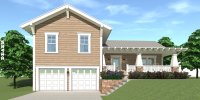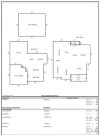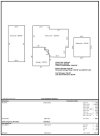Okay. Assume you work in a place where the MLS reports total heated (or finished) area of split levels or split foyer designs with little or no attention to what is below grade and what isn't. Your subject is a split level. The lowest level is fully finished and is also below grade. You measure and report GLA in accordance with ANSI so, that lower level will be reported as finished basement. The other levels will be GLA. That's page one of the 1004. On page two, all of the finished area is included in the SF line of the sales comparison grid... just like what the MLS reports for the comparables (also split level)... and you make adjustments based on those differences. Your comments will say something like... "It is common and accepted practice in the subject market to report all finished area, both above and below grade, as the square footage of the property. Buyers and Sellers in this market typically think in terms of total finished area. In the description sections of the appraisal report, the subject dwelling has been described in conformance with GSE requirements. In the sales comparison grid, the square footage of the subject dwelling has been reported in accordance with local market practice in order to facilitate direct comparisons and adjustment.'
.
If you have comparable sales data that adequately breaks out finished/unfinished, above grade/below grade areas then, there is no need to jump through any hoops.
Let me give you a real life scenario that prompted this question: Using the county records....above grade and below grade SF are clearly separated. Subject is a tri-level home with the living room located behind the garage. From the garage, you have a doorway that opens to the living room. The living room is all above grade. From the living room....you go up a 1/2 flight of stairs to the kitchen, entryway and office. From the living room, you can also go down to a 500 SF finished basement that has a bedroom, bath and craft/laundry room. From the mid level entryway, you go up a half flight of stairs to the upper level with 3 bedrooms and 2 full baths.
Appraiser researches comps prior to visiting the property. Within a 2 mile search, the appraiser states that he can't find any homes with 500 SF basement. Because of this, the appraiser adds the 540 SF above grade living room into the basement line to bump up the basement SF and calls the home a bi-level. Appraiser doesn't value the basement area the same as above grade area which results in a lower value. Appraiser is fully aware that the living room is above grade. In other words, this wasn't just a mistake.
The subject has an attached 2-car garage as well as a 800SF detached garage/shop with a storage loft of over 500SF. The shop has a 12' high commercial roll up door and the interior height can accommodate a car lift. The appraisal doesn't use any comps with a detached shop and states the shop has inferior utility to an attached garage. Comps with 3 car attached garages receive no adjustment for the detached shop amenity. Comps with attached 2 car garages receive an upward stall adjustment. The subject detached shop by itself is larger in SF than the 3 car comps. The 500+ SF storage loft receives no contributory value. Detached shops in this market have excellent appeal and with an expanded search you will find sales with similar detached shops.
In my 20+ years of appraising I've never seen where an appraiser deliberately puts GLA in the basement area. Yes, I've seen finished basement area included in the above grade line. And yes, I've seen finished basement area valued the same as above grade area....especially on hillside homes.
Please pick this apart and tell me if you agree or disagree with the approach the appraiser used on this real life example. I'm not looking to over react....and therefore would like to seek your opinions on this. Disclaimer: This is my personal home and yes, I have emotions involved.
Note: I've attached a photo of a similar tri-level design. I've also attached the appraisers sketch and my sketch.







